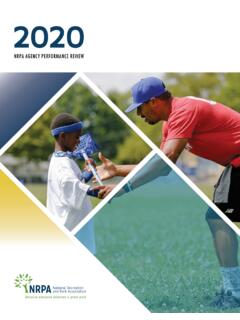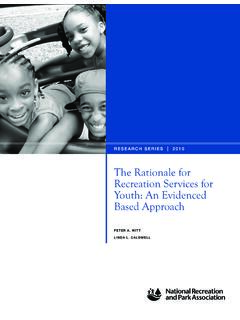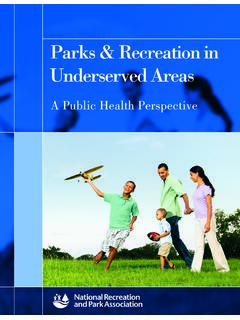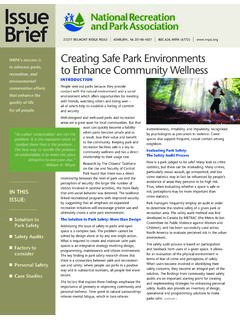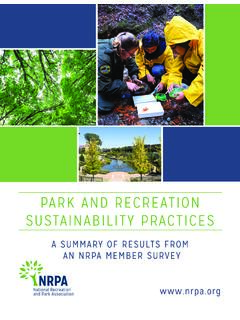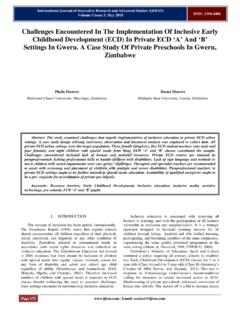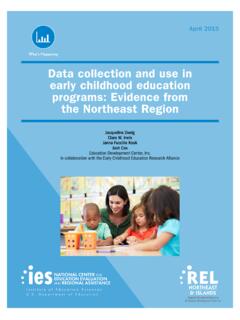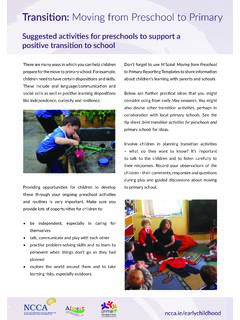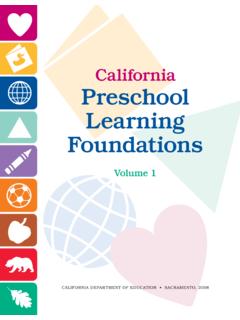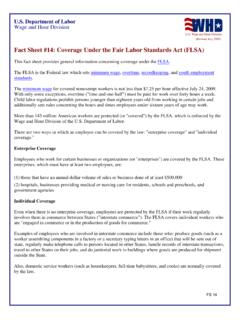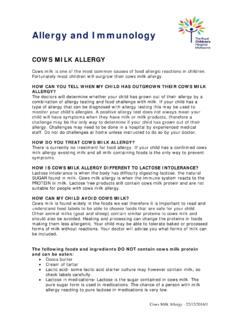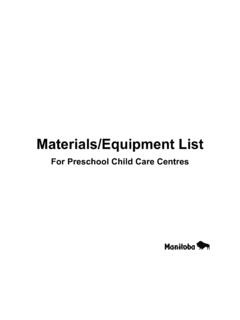Transcription of THE DAILY DOZEN - National Recreation and Park Association
1 THE. DAILY . DOZEN . A 12-Point Playground Safety Checklist As parents and caregivers, we are responsible for providing and ensuring safe play opportunities for our children. By familiarizing yourself with the DAILY DOZEN Playground Safety Checklist you can learn to help identify safety hazards and help keep our children safe. Should you notice any of the following hazards on your child's playground, immediately notify the owner/operator about the condition of the play areas, so that they may take the necessary steps to eliminate those hazards. NRPA's The DAILY DOZEN A 12-Point Playground Safety Checklist 1. PROPER SURFACING. The surface under and around playground equipment should be soft enough to cushion a fall.
2 Maintaining proper surfacing is one of the most important factors in reducing the likelihood of playground injuries. Surfacing should be checked routinely for trip hazards, kick-out (displacement), debris and proper drainage. When selecting playground surfacing it is important to ensure your surfacing meets the requirements of the ADA standards. Acceptable surfaces include: Unacceptable surfaces include: engineered wood fiber concrete wood chips blacktop sand packed DID YOU KNOW? pea gravel earth Temperature, UV rays, synthetic/rubber tiles grass and climate conditions shredded rubber can effect the shock mats absorbing properties of poured-in-place playground surfacing.
3 Impact attenuating synthetic turf 2. ACCESSIBILITY. Equipment selection and location along with the type of protective surfacing are key components to ensuring opportunities for children with disabilities to play on the playground. The Americans with Disabilities Act (ADA) requires newly constructed playgrounds and existing playgrounds that are altered to comply with the provisions set forth in the ADA guidelines. These guidelines establish minimum accessibility requirements including access and accessible routes, variety and number of play opportunities and appropriate surfacing beneath all accessible components. 3. ADEQUATE SUPERVISION.
4 Play areas should be designed so it is easy for a parent or caregiver to observe the children at play. Posted signs on the playground should be easily viewable by supervisors. Supervisors should understand the basics of playground safety. Visit for more information 4. AGE APPROPRIATE EQUIPMENT. It is important to make sure the equipment in the playground setting is appropriate for the age of the intended user. Signs and labels must be posted indicating the age of the user for which equipment is intended. The US. Consumer Product Safety Commission does not recommend the following for preschool users free-standing arch climbers, free-standing flexible climbers, chain and cable walks, fulcrum seesaws, log rolls or vertical sliding poles.
5 5. PROPER EQUIPMENT. Some playground equipment is not DID YOU KNOW? recommended for use on public playgrounds, Overhead hanging rings that these include: trampolines, swinging gates, have a short chain (7 or heavy metal swings, free swinging ropes, less) are allowed on public swinging exercise rings and trapeze bars. playground equipment. 6. ADEQUATE USE ZONES. Use zones are the area around playground equipment onto which a child would fall. A minimum of 72 is required around all playground equipment. Depending on the type of equipment and motion involved, many pieces of equipment require larger use zones. Use zones must have proper surfacing.
6 Equipment Spacing and Use Zones Use zones in front and to the rear of swings should be twice the height of the pivot point of the swing. An 8'-high swing should have a 16' use zone in both directions 16' minimum 8' pivot point 6' minimum Side use 16' minimum zones may overlap 6' minimum Front-to-rear use zones may not overlap 7. PROTRUSION AND ENTANGLEMENT HAZARDS. A protrusion hazard is a component or piece of hardware that is capable of impaling or cutting Bolt ends should not protrude a child, if a child should fall against the hazard. Some protrusions are also capable of catching strings or clothing. This type of entanglement is especially hazardous because it can result in strangulation.
7 Increased diameter Examples of protrusion and entanglement creates a hook hazards include: bolts that extend more than two threads beyond the face of the nut hardware configuration that forms a hook open S hooks; rungs or handholds that protrude outward 8. HEAD AND NECK ENTRAPMENT. All enclosed or partially enclosed openings must be checked for potential head or neck entrapment. Generally, there should be no openings on playground equipment that measures between and 9 inches. Pay special attention to openings at the top of slides, between platforms and on climbers. Guardrails and enclosures on elevated platforms DID YOU KNOW? Check for Enclosed openings entanglement measuring Children should always hazards at the between.
8 Remove their bike entrance to the and 9 should helmet before playing slide bedway be checked for on a playground head entrapment to protect against hazards entanglement or entrapment. 6' minimum 6' minimum 6' minimum 8' maximum 9. TRIP HAZARDS. Playgrounds with high use should be scanned DAILY for trip hazards, including: exposed concrete footings abrupt changes in surface elevation tree roots tree stumps rocks 10. CRUSH, SHEAR AND SHARP EDGES HAZARDS DID YOU KNOW? Components on the playground should be kept Crush and shear hazards free of sharp edges and moving components are found in locations should be checked for the potential of crush and where parts move against shear injuries.
9 To determine if there is a possible each other or against crush or shear point, consider the likelihood a a fixed part such as child could get a body part inside the point and on fulcrum see-saws, suspension bridges, track the closing force around the point. rides, swings, whirls, and roller slides. 11. PROPER MAINTENANCE. In order for playgrounds to remain safe, a program of systematic, preventive maintenance should be in place. Routine inspection of playground areas include checking equipment for broken or missing pieces, cracks, rust or deterioration, and loose anchoring. As well as checking surfacing for debris, displacement, proper drainage and checking surrounding environment for trash, vandalism and modifications.
10 12. INSPECTED BY A CERTIFIED INSPECTOR. Part of a sound risk management plan should include having your playground inspected routinely by a Certified Playground Safety Inspector (CPSI). CPSIs are certified as knowledgeable on the most current playground safety standards and guidelines and must maintain their certification every three years. Visit for more information BECOME A CERTIFIED PLAYGROUND. SAFETY INSPECTOR. The best way to recognize and prevent potential playground hazards is to be properly trained by becoming a Certified Playground Safety Inspector (CPSI). This nationally recognized certification will not only help you ensure children have safe places to play, it will also allow you to: Open the door to a new career opportunity inspecting playgrounds Be associated with NRPA's strong and long-standing reputation in playground safety Protect your business or other businesses from costly liabilities Confidently inspect the safety of playgrounds based on National standards and guidelines GET CERTIFIED TO PROTECT YOUR PLAYGROUNDS.


